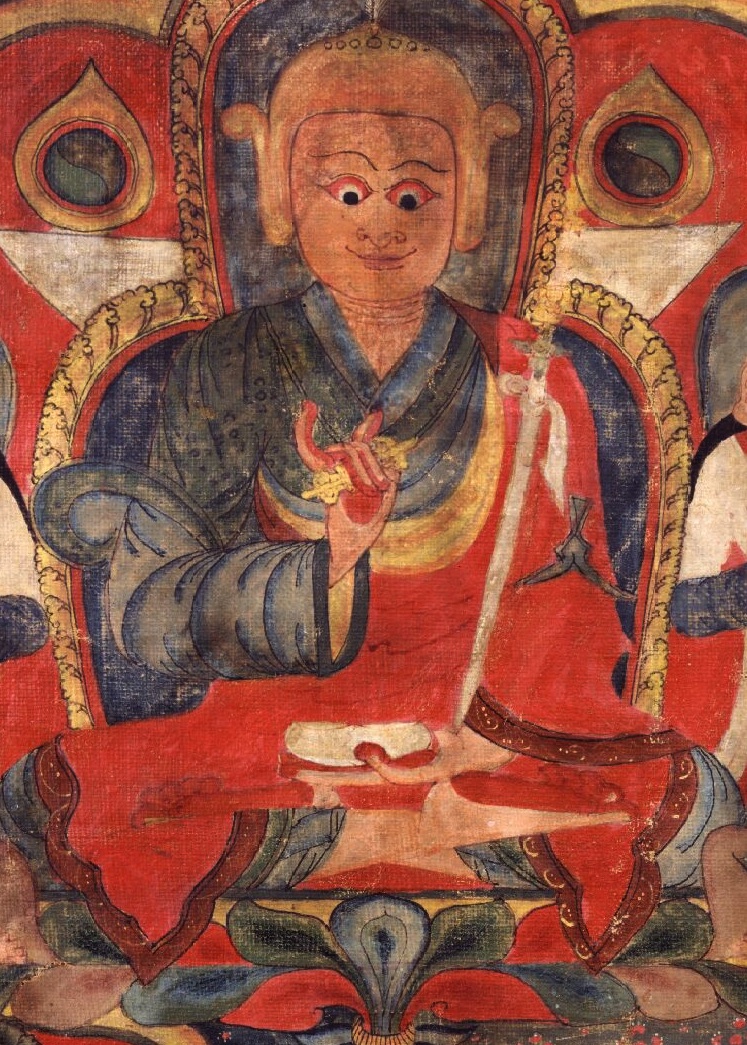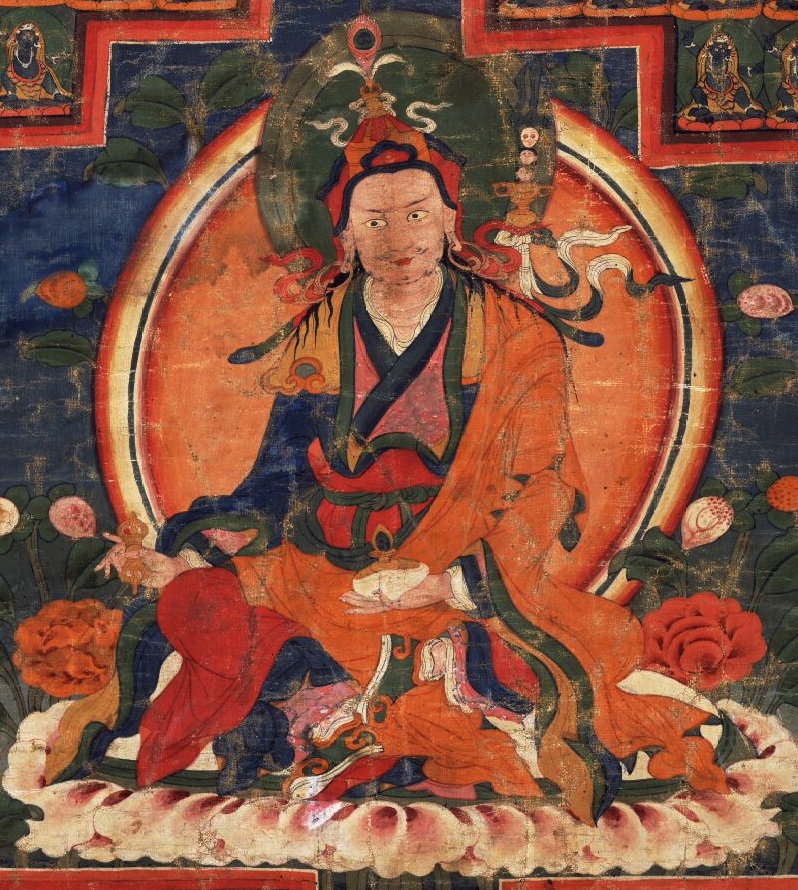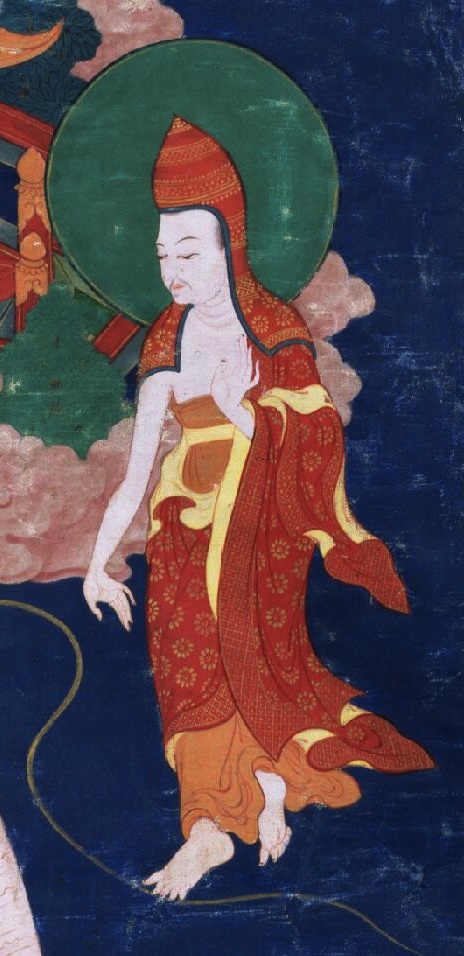Biography and autobiography in Tibet are important sources for both education and inspiration. Tibetans have kept such meticulous records of their teachers that thousands of names are known and discussed in a wide range of biographical material. All these names, all these lives—it can be a little overwhelming. The authors involved in the Treasury of Lives are currently mining the primary sources to provide English-language biographies of every known religious teacher from Tibet and the Himalaya, all of which are organized for easy searching and browsing. Every Tuesday on the Tricycle blog, we will highlight and reflect on important, interesting, eccentric, surprising and beautiful stories found within this rich literary tradition.
Nyingma Founders, Part 1: Padmasambhava
 Over the next few months we will be making occasional posts on major figures in the early development of the Nyingma tradition. Today we begin, naturally, with Padmasambhava. Like other figures from the early days of Tibetan history, Padmasambhava presents an issue for the Treasury of Lives in that he is alternately regarded as a person and a buddha. While Padmasambhava almost certainly lived a human life, and visited Tibet, the biographical materials that have developed around his person transformed him into a deity with an enormous sphere of activity in both Buddhist and Bon traditions. We’ve tried to limit the biography on the Treasury to the historical core, but even that is difficult to access—there are simply too few reliable early sources. What we do know is that the transformation of Padmsambhava from person to deity was a key moment in the organization of the Nyingma and its treasure tradition.
Over the next few months we will be making occasional posts on major figures in the early development of the Nyingma tradition. Today we begin, naturally, with Padmasambhava. Like other figures from the early days of Tibetan history, Padmasambhava presents an issue for the Treasury of Lives in that he is alternately regarded as a person and a buddha. While Padmasambhava almost certainly lived a human life, and visited Tibet, the biographical materials that have developed around his person transformed him into a deity with an enormous sphere of activity in both Buddhist and Bon traditions. We’ve tried to limit the biography on the Treasury to the historical core, but even that is difficult to access—there are simply too few reliable early sources. What we do know is that the transformation of Padmsambhava from person to deity was a key moment in the organization of the Nyingma and its treasure tradition.
What do we reliably know about Padmasambhava the person? Very little, almost all of it gleaned from legend. The kernel of the story is this: born in a region of northern India (possibly in a place called Oddiyana), he spent time in the Kathmandu Valley mastering the then-emerging techniques of Mahayoga, which include the Vajrakila tradition that is now shared between the Nyingma and Sakya sects. These practices, known for their violent language and imagery, were sought after as a means to subjugate demons and other negative forces.
 While Padmasambhava was practicing at the caves of Yanglesho, Muratika, and Asura in Nepal, Tibetan king Trisong Deutsen (742–796) was constructing Samye Monastery under the direction of the Indian pandita Shantarakshita in order to establish Buddhism in Tibet. Facing opposition from indigenous forces—legend has it that each night local Tibetan spirits dismantled everything that was built during the day—Shantarakshita urged the king to invite Padmasambhava to subjugate them. Padmasambhava’s ensuing conquest of of the deities at Samye, enabling the monastery to be built, remains a formative event in the spread of Buddhism to Tibet.
While Padmasambhava was practicing at the caves of Yanglesho, Muratika, and Asura in Nepal, Tibetan king Trisong Deutsen (742–796) was constructing Samye Monastery under the direction of the Indian pandita Shantarakshita in order to establish Buddhism in Tibet. Facing opposition from indigenous forces—legend has it that each night local Tibetan spirits dismantled everything that was built during the day—Shantarakshita urged the king to invite Padmasambhava to subjugate them. Padmasambhava’s ensuing conquest of of the deities at Samye, enabling the monastery to be built, remains a formative event in the spread of Buddhism to Tibet.
 Other historical sources suggest that Padmasambhava might have been an expert in irrigation. The association of demon taming and irrigation might not be obvious until one remembers that many subterranean deities are connected to water, and to change the flow of water one would have to win the deities’ approval or coerce them.
Other historical sources suggest that Padmasambhava might have been an expert in irrigation. The association of demon taming and irrigation might not be obvious until one remembers that many subterranean deities are connected to water, and to change the flow of water one would have to win the deities’ approval or coerce them.
Conquest of local deities is a standard trope in religious conversion narratives, and the event, characterized quite violently in the literature, speaks to the resistance of the local priests, if not the populace, to the new religion. Whatever was there before Padmasambhava arrived would later be reorganized, in a much-altered form, as Bon. Interestingly, despite Padmasambhava’s apparent role in suppressing the Bon establishment, later Bon traditions claim him as a Bon teacher.
The subjugation of spirits and Buddhism’s impact on the local landscape served as bases for the subsequent development of Padmasambhava’s legend. Starting around the early 12th century, biographies were written in which Padmasambhava went to specific places to repeat his triumph at Samye, where he would conquer a hostile spirit and convert it to a protector of Buddhism, and would literally insert a sacred Buddhist object or text into the rock or soil. Centuries later, this object would be recovered by a terton, or “treasure revealer,” who would tell the tale of how Padmasambhava originally concealed the object. Thus, with each new treasure came a new chapter in the biography of Padmasambhava, to the extent that in Tibet today there is hardly a valley or mountain that he is not said to have visited.
Continue to Part 2: Dampa Deshek
Read the full Padmasambhava biography over at Treasury of Lives.
Thank you for subscribing to Tricycle! As a nonprofit, we depend on readers like you to keep Buddhist teachings and practices widely available.